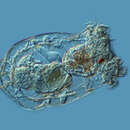en
names in breadcrumbs


Lorica generally more or less flattened dorso-ventrally and distinctly stiffened; antero-dorsal margin with 6, 4 or 2 spines; antero-ventral margin undulate with small median notch; with or without posterior spines at postero-lateral edges and at foot opening. Foot very long, more or less wrinkled, retractile. Two short, usually conical toes. Corona with 5 distinct lobes and sensory bristles. Single cerebral red eyespot. Rami roughly triangular, broad, rounded externally with conspicuous anterior projection. Fulcrum short and broad; median rami margin with reinforced ridge of zig-zag like processes. Unci plate-shaped, composed of almost completely fused teeth, decreasing in length dorsally; subunci present. Manubria characteristic, broad, triangular, bent inwards distally. Additional trophi elements or satellites are connected to rami and unci by ligaments.
TYPE SPECIES ‒ Brachionus urceolaris Müller, 1773
Brachionus is a genus of planktonic rotifers occurring in freshwater, alkaline and brackish water.
Species included in Brachionus include:[2]
Rotifers such as Brachionus calyciflorus are favored test animals in aquatic toxicology because of their sensitivity to most toxicants. They also are used as model organisms in various other biological fields e.g. due to their interesting reproductive mode in evolutionary ecology. Brachionus spp. are easily reared in large numbers and because of this are used to substitute for wild zooplankton for feeding hatchery reared larval fish. However, the composition of rotifers generally does not satisfy the nutritional requirements of fish larvae,[3] and large amounts of research have been invested in improving the lipid, vitamin and mineral composition of rotifers to better meet the requirements of fish larvae[4][5][6]
Brachionus species can normally reproduce sexually and asexually (cyclical parthenogenesis). Sexual reproduction (termed Mixis) is usually induced when population density increases. Mixis in Brachionus plicatilis has been shown to be induced by a density-dependent chemical cue.[7]
Transitions to obligate parthenogenesis have been described in Brachionus calyciflorus. In this species, obligate parthenogenesis can be inherited by a recessive allele, which leads to loss of sexual reproduction in homozygous offspring.[8][9] In Brachionus manjavacas rotifers, offspring's survival and its cell's ability to growth and division decrease with advancing age of mother.[10]
Haploid '1C' genome sizes in Brachionus species range at least from 0.056 to 0.416 pg.[11]
The complete mitochondrial genome of B. plicatilis sensu stricto NH1L has been sequenced.[12]
Brachionus plicatilis has been demonstrated to be a large cryptic species complex consisting of several different species.[13] It has a worldwide diversity of at least 14 - 22 cryptic taxa.[14][15]
Brachionus calyciflorus also seems to be a cryptic species complex.[16]
Huang, L. "Effectof Aldrin on Life History Characteristics of Rotifer Brachionus calyciflorus Pallas." Bull Environ Contam Toxicol no5 N 2007
 Brachionus quadridentatus
Brachionus quadridentatus Brachionus is a genus of planktonic rotifers occurring in freshwater, alkaline and brackish water.